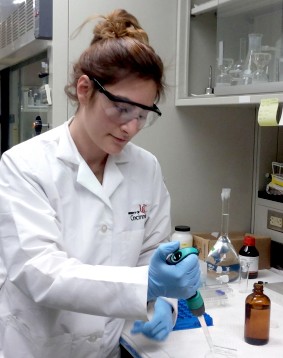
Sensor detects toxins in drinking water sources
University of Cincinnati researchers develop early warning detection of toxins
University of Cincinnati researchers have developed a sensor that detects toxins from algal blooms that taint surface water such as rivers, lakes and streams. Early detection of these toxins can aid water treatment plants to adjust the treatment strategy to keep the dangerous substances from contaminating drinking water.

Dionysios Dionysiou, UC professor of environmental engineering.
The research is led by Dionysios Dionysiou, professor of environmental engineering, with his student, Vasileia Vogiazi, who recently earned her doctoral degree from UC in environmental engineering.
The researchers created an electrochemical aptamer-based sensor that detects and measures microcystin cyanotoxin in water. Microcystins are the toxic byproducts of harmful algal blooms, which develop when fertilizer used in agriculture leaches into bodies of water. Exposure through drinking water may cause liver damage, tumor growth and gastroenteritis.
Once the cyanotoxins are detected in the finished drinking water it’s more challenging to remove — which occurred in Toledo, Ohio, in 2014 and led to a do-not-drink order for 500,000 consumers. Early detection with the sensor in the freshwater source, such as Lake Erie in the Toledo case, would alert water treatment plants to the presence of the toxins before the water enters the treatment facility.
“Conventional treatment processes are not always efficient in removing cyanotoxins. Contaminated water with these toxins is harder to treat,” Vogiazi said. “If the toxins pass several treatment stages, an unfortunate increase in the cost and major difficulties in the general management of a treatment plant is expected.”

Vasileia Vogiazi recently earned her doctoral degree from UC in environmental engineering.
Funded by a grant from the National Science Foundation, the findings were published in the journal ACS ES&T Engineering.
Project collaborators included researchers from across several disciplines at UC: Vesselin Shanov, professor of chemical engineering; Ryan White, associate professor of electrical engineering and chemistry; and Bill Heineman, distinguished research professor of chemistry. Researchers from the Environmental Protection Agency — Armah de la Cruz and Eunice Varughese — also contributed.
“Vasileia was very motivated. She went over the typical environmental engineering kind of training,” Dionysiou said. “She went to the chemistry department to learn aspects related to the electrochemistry and sensor development, she did some testing with a company that makes aptamers, and she had amazing support with sensors from Professor Bill Heineman and Professor Ryan White.”
Using water samples taken from Lake Erie and other Ohio bodies of water, the researchers employed their sensor to successfully detect and measure the amount of a specific type of microcystin commonly found in the region. The next step for future research is to expand the types of toxins the sensor can detect and create a prototype device to be used in the field.
“We focused on microcystins which are very commonly found here in Ohio and other places, but there are other important toxins, so we want to develop modified sensors that can be selective for other toxins, as well as sensing devices that can detect and quantitatively measure multiple cyanotoxins in water,” Dionysiou said.
Video courtesy of National Science Foundation.
Featured image at top: A satellite image of algal blooms on Lake Erie. Photo/NASA.
Related Stories
UC professor Ephraim Gutmark elected to National Academy of...
December 20, 2024
Ephraim Gutmark, distinguished professor of aerospace engineering at the University of Cincinnati, was elected to the 2024 class of the prestigious National Academy of Inventors.
UC students use 1819 Makerspace to build award-winning scoliosis...
December 18, 2024
Three University of Cincinnati students used the 1819 Ground Floor Makerspace to invent and test a groundbreaking treatment for pediatric scoliosis.
Chamberlain Group and the power of co-op
December 16, 2024
For two decades, the Chamberlain Group and UC have partnered on cooperative education experiences. Chamberlain Group, a global leader in intelligent access, provides hands-on experience for students in fields such as engineering, industrial design and communication design.
